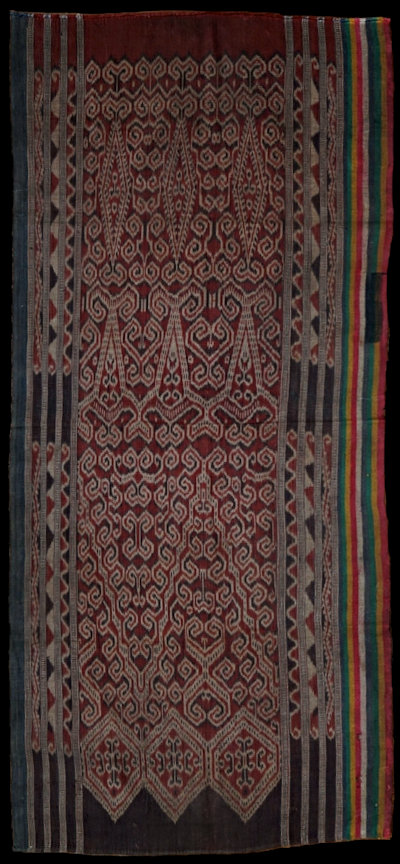| |
 
 | | | |
317 Borneo, Kalimantan
Kain kebat (skirt)
| | Locale: | Ketunggau river system | | Period: | 1900-1920 | | Yarn: | Cotton, hand-spun, very fine - plus pinstripes in quad-ply commercial cotton | | Technique: | Warp ikat | | Panels: | 1 | | Size: | 50 x 112 cm (1' 7" x 3' 8") LW: 2.24 | | Weight: | 138 g (4.9 oz), 246 g/m2 (0.81 oz/ft2) | | Design: | Tripartite field division that is characteristic of Ketunggau skirts. The upper half, marked out by unpatterned sections in the borders, has scrolls arranged in pyramids. The middle quarter features the primary motif that is typical of Ketunggau designs: an elongated triangle with extensions, each ending in double fins (like a fishtail). The bottom quarter has three simple, evenly spaced long diamonds with feathery borders, echoing the diamonds at the top border. The shapes, movements and textures of the motifs form pleasing balances and contrasts. Of note is the exceptionally deep red of the ground. The borders have three ikat strips in different designs, separated by ribbed lines of blue/white warp-faced float weave. Very unusual is the unilateral decoration with pre-dyed commercial yarn, which was not seen before. While it is clear that the addition of commercial thread (available only for money, a rare commodity in the inland of Kalimantan) served pecuniary emulation, it is unclear why the weaver chose to add it only on one side, rather than divided it over the two sides of the single panel skirt. | | Comment: | The designs and dyes used by the people living along the Ketunggau river are similar to those of the Iban in Sarawak, a manifestation of common ancestral roots, but also show interesting differences, especially stronger graphic outlines and compositional order. The extremely fine hand-spun cotton (note the very low specific weight) supports early dating. There is an enigmatic black rectangle covering a section of the multicoloured side band. While looking like a patch, it was created by applying dyestuff to the woven cloth over a carefully delineated surface. The meaning of this tertiary decoration could not be ascertained. | | Background: | Chapters on Borneo and Kalimantan. | | Compare: | 212 220 229 300 243 | | |

©Peter ten Hoopen, 2024
All rights reserved.
|
|


